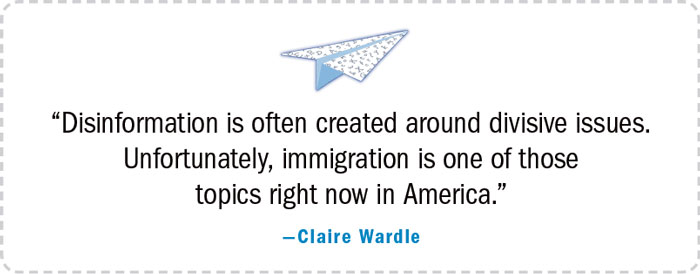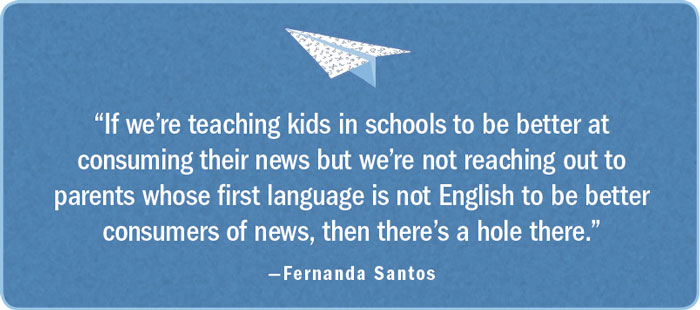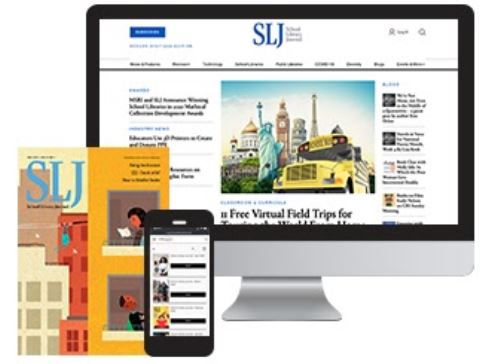Educators Face Challenges Teaching Media Literacy to Immigrant Students
Lack of English fluency, a multilingual media diet, and parents who may be unable to serve as gatekeepers are just a few of the issues facing immigrant students learning to distinguish credible stories from disinformation.
 |
Illustration by James Steinberg |
In May, Fernanda Santos went to Ciudad Juárez, a Mexican city bordering El Paso, TX, to train local journalists on how to objectively cover the flow of Central American migrants passing through the country to reach the United States.
While in Juárez, the former New York Times Phoenix bureau chief spoke with a nun in charge of a migrant shelter. The woman told Santos of a false story circulating. The story described a deal President Trump struck with the Mexican government that would allow migrants from Mexico free passage into the United States, while migrants from Central American countries would be barred.
This story was not true, but according to Santos, it had been rapidly spreading through the shelter on WhatsApp, sparking an argument between a Honduran woman and a Mexican woman, causing “tension in a place that’s already full of tension.”
“Not only are they consuming news that they can’t tell is true or false,” says Santos, now a journalism professor at Arizona State University, “but they also don’t know where it came from.”
Misinformation and its often destructive effects on a community are now at the forefront of the national conversation. Librarians in particular are grappling with how to teach children to distinguish a credible source from a spurious one, to recognize bias, and to account for their own emotions when judging media. Initiatives such as the News Literacy Project and MediaWise support these goals, sharing best practices to help cast the widest net.
But new immigrant children may be slipping through. There are few media literacy projects designed with them in mind, programs that would address the specific barriers they may face, such as lack of English fluency, a multilingual media diet, and parents who may not be able to serve as gatekeepers. Combine that with the growing research that much “fake news” is about new immigrants, generating consternation in those communities, and you begin to appreciate the complexity of the problem.
“Disinformation is often created around divisive issues. Unfortunately, immigration is one of those topics right now in America,” says Claire Wardle, a TED fellow and chair of First Draft News, a nonprofit “working to address challenges relating to trust and truth in the digital age.” “We therefore see a disproportionate amount of false or misleading content.”
Frank W. Baker, a media literacy consultant who works with school librarians across the country, suspects that being the targets of heated disinformation campaigns could be taking a toll on these already vulnerable new immigrants.
While the existence of misinformation and doctored news has gotten more attention over the last few years, the concept of “alternative facts” is not new. In 2005, comedian and talk show host Stephen Colbert coined the word “truthiness.”
“We’re not talking about truth,” he said on his late-night talk show at the time, referring to instances like the Bush administration’s justification for invading Iraq. “We’re talking about something that seems like truth—the truth we want to exist.”
“Truthiness” caught on—Merriam-Webster named it the 2006 word of the year—and more than a decade later, it’s a concept that remains at the core of the most effective disinformation campaigns.
“News tends to filter through a lens that confirms our own biases,” says Jennifer LaGarde, a digital literacy consultant and coauthor of Fact vs. Fiction: Teaching Critical Thinking Skills in the Age of Fake News. LaGarde, who retired in 2018 after 20 years in education, 10 as a school librarian, says that emotion can be a powerful distorting force, and any media literacy effort needs to account for it.
We need, LaGarde says, to help “kids recognize how news is tailored to trigger a reaction, and help them manage those triggers.” But schools tend to shy away from these conversations, “because they don’t want to engage in conversations that are going to be controversial.”

An unmet need
On March 19, more than 200 Seattle-area high schoolers trekked to the University of Washington Information School for “MisInfo Day,” a daylong workshop on misinformation. Students were pressed to examine their beliefs in order to better understand confirmation bias, according to Liz Crouse, a graduate of the Information School and one of the organizers of the event.
“We asked them, ‘Is it because you’ve seen lots of evidence for this belief, or is it because the media has ingrained it in you?’” recalls Crouse, who started as the librarian at Nathan Hale High School in Seattle this fall.
Benjamin Kort, a media specialist at Fircrest Elementary School in Vancouver, WA, has designed a primer on fake news for fourth and fifth graders. Over the course of four half-hour lessons, Kort tries to teach his students to understand the various types of information manipulation (such as disinformation, clickbait, and ads disguised as news); distinguish a fake story from a real one with the help of Ammi-Joan Paquette and Laurie Ann Thompson’s Two Truths and a Lie; learn how to evaluate sources; and, finally, do their own research.
“If I can give them the foundational tools, and instill a skepticism in them to question everything they read,” Kort says, “that’s a fundamental skill for them to navigate pretty much the entire future.”
His materials do not specifically address particular challenges new immigrant children might face, however, nor did “MisInfo Day” or several other media literacy initiatives gaining steam nationally. The overwhelming majority of initiatives being tried are in English and don’t account for language barriers, parental bias, and other factors. In other words, the group that most desperately needs these skills isn’t being addressed.
Peter Adams, the senior vice president of education at the News Literacy Project, an educational nonprofit that uses e-learning to teach librarians media literacy best practices, describes the inability to tailor lessons to new immigrants as a “capacity issue.” NLP has a staff of just 23 people, he says, and though it has transitioned to a scalable e-learning platform, teaching news literacy to a child whose media diet may include Spanish, Arabic, or other languages involves much more than simple translation. One of NLP’s flagship modules, “Practicing Quality Journalism,” is available in Spanish with examples from Spanish-language media, he notes.
At Dearborn Park International Elementary in Seattle, teacher-librarian Craig Seasholes says the large Somali immigrant community in his region presents challenges for some of his secondary school colleagues looking to boost media literacy.
“We have so many Somali students who are dealing with both religious and national information sources that I don’t have access to that are quicksilver,” he says of the dubious sources. “And ‘quicksilver’ is a respectful term.”
Monitoring social media can be a particularly tricky challenge, according to Daniel Funke, a reporter at PolitiFact, a nonprofit news site operated by the Poynter Institute. While Twitter is relatively easy to comb through to monitor, Facebook—still by far the most popular platform for disinformation—is not. “And there’s virtually no monitoring ability on Instagram,” Funke says.
PolitiFact has partnered with Facebook to help the social media behemoth flag false news. After the El Paso mass shooting in August, it marked as false a rapidly spreading meme that claimed ICE was checking the citizenship status of families who gathered after the attack.
Disinformation tends to seep into mainstream discourse through social media. Incendiary language becomes normalized by social media and by the more mainstream reports as well.
“You don’t even need to go to the fake news world, sadly,” Santos says.
A New York Times investigation published in August found that “demonizing references to immigrants have become more widespread in the news media” since Trump came to political prominence.
“Before the first groups of Central American migrants received heavy news media coverage in 2018, words like ‘invaders’ or ‘invasion’ were rarely used by American outlets,” the Times reported. “In the last year, the use of such terms has surged, with references to an immigrant ‘invasion’ appearing on more than 300 Fox News broadcasts.” This phenomenon is certainly not unique to the United States—in the run-up to the Brexit referendum, there was a torrent of racist disinformation about immigrants to the United Kingdom.

Power of misinformation
Maribel Martinez is a Seattle-based immigration attorney who regularly works with migrants from countries such as Honduras and Guatemala that are very much in the crosshairs of the false stories. She says misinformation campaigns work even if people don’t find them credible, because they make immigration supporters focus on countering negative perceptions of new immigrants rather than promoting the value that they can bring to their new communities.
The letters of support people write for these new immigrants, Martinez says, “will focus on the narratives in the ‘fake news.’ All of that is frustrating especially because it has a tangible impact on how [immigrants] are perceived and how they are treated in every level of our society.”
Misleading stereotypes about new immigrant communities have an impact on the mental health of children in these communities, Martinez says. It “creates fear, anxiety, depression and doubt” and impacts their ability to concentrate and perform well in school.
“We’re seeing a lot of bullying and bias aimed at people who are immigrants and people who are refugees,” says Jinnie Spiegler, director of curriculum and training at the Anti-Defamation League (ADL). And that vitriol is impacting student engagement and attendance, Spiegler adds, with “families being scared to send their kids to school.”
The ADL conducts anti-bias education programs in schools with students and teachers who try to address these issues, and offers downloadable lesson plans on some of the hot-button issues of the moment, such as the “migrant caravans.” The programs incorporate real-life scenarios.
It’s a delicate balance to strike, Spiegler says. “You don’t want targeted students to feel more uncomfortable.”
The ADL sees value in addressing misconceptions about new immigrants through literature and a mirrors-and-windows approach. The organization has an online bibliography of more than 700 titles that feature stories about different new immigrant communities and a book of the month that can help build empathy among students and educators by giving them a window into a community. Past selections include Duncan Tonatiuh’sUndocumented: A Worker’s Fight and Hena Khan’s Under My Hijab.
Martinez and others stress that for media literacy efforts to really work among new-immigrant communities, there needs to be a greater awareness of the biases that these communities might be carrying with them about the role the press plays in society.
“My clients are coming from countries where there is a level of mistrust about what is reported, because of the level of corruption that reaches up to journalists,” Martinez says. “Sometimes they [the journalists] won’t report the whole truth, because they would rather live,” she adds.
New immigrant parents internalize this skepticism, Martinez says. It stays with them after they move to the United States and may trickle down to their children. That said, parents can still be some of the most important media literacy gatekeepers, and schools can help.
“Schools have a real opportunity and obligation to partner with parents in this work,” says LaGarde. “If the community is digesting news from different countries and different sources in different languages, then they [parents] can help curate sources to help teach media literacy.”
Addressing the issue with a multilingual solution is vital, but most programs fall short, developed with the idea that the United States is an English-only not an English-dominant country, according to Santos.
“If we’re teaching kids in schools to be better at consuming their news but we’re not reaching out to parents whose first language is not English to be better consumers of news, then there’s a hole there,” Santos says. “Some kids might be able to jump over the hole. But other kids may fall in and get lost.”
Hiten Samtani is The Real Deal’s associate publisher and editorial director, overseeing the West Coast region. He has written about education for the New York Times and WNYC.
RELATED
The job outlook in 2030: Librarians will be in demand
The job outlook in 2030: Librarians will be in demand
ALREADY A SUBSCRIBER? LOG IN
We are currently offering this content for free. Sign up now to activate your personal profile, where you can save articles for future viewing






Add Comment :-
Be the first reader to comment.
Comment Policy:
Comment should not be empty !!!